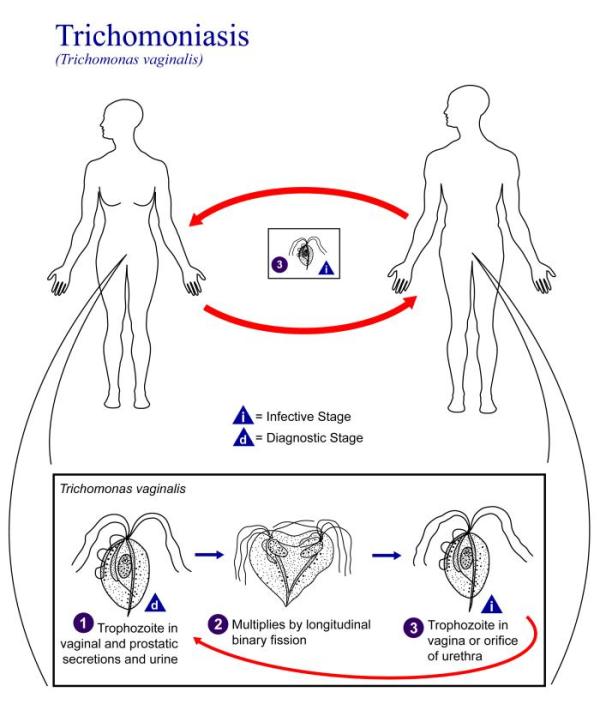Trichomonas vaginalis: Morphology, Habitat, Nutrition, and Life Cycle
Morphology
T. vaginalis
is a single-celled, teardrop shaped protist that can grow
between five and 20 micrometers wide. Four anterior and one
posterior flagella allow T. vaginalis to move. The
posterior flagellum is part of the center axostyle, and has a
barbwire-like structure. This structure allows the protist to attach to
and tear the urethra or vaginal walls, which causes inflammation
and aids in speeding and
intensifying infection. T. vaginalis has a cell
membrane, but lacks a cell wall. Half of the cell body
also has an undulating membrane, which helps sweep nutrients into the protist's mouth-like structure, called
the cytosome. A visible nucleus is located at the organism's
center.
.
Habitat
Parabasalids like
T. vaginalis are not free living organisms. They
require a human or animal host. T. vaginalis has a
worldwide distribution. In men, the organism lives in
the urinary tract, most commonly the urethra or prostate, where
as in women, it is found in the reproductive tract, usually in
the vagina. A healthy vagina is a somewhat acidic environment
(pH 3.8-4.2). When pH is thrown off and becomes more basic, if
T. vaginalis is present, it can cause infection. T.
vaginalis is most successful in an enviroment with pH near
6, however, it is a fairly resilient protist, and can survive about
24 hours in urine, semen, or water.
Nutrition
Like other
parabasalids, T. vaginalis acquires nutrients through
cell membrane transport and phagocytosis. The undulating
membrane assists in this process.
Bacteria, archea, and even
parts of the vaginal wall are consumed. Enzymes break down these
food sources and convert them to useable energy through
glycolysis. T. vaginalis lacks a traditional
mitochondria, like all other Excavates. In place of a true
mitochondria, there is a reduced form known as a hydrogenosome.
Hydrogen gas is a by-product of the hydrogenosomes.
Reproduction and Life
Cycle
T. vaginalis
reproduces asexually through longitudinal fission. The
trophozoites (adults) then live in the urinary or reproductive
tracts, until they are passed onto their next human host via
unprotected sexual contact, where the whole process starts over
again. Unlike many other protists, T. vaginalis does
not have a cyst stage as part of reproduction.
